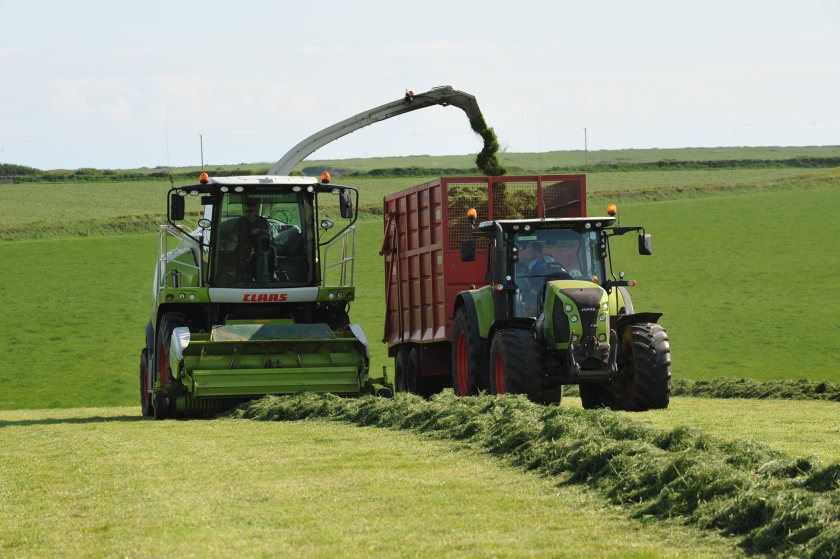
Farmers are being warned not to cut corners on safety as pressure mounts to get work done following challenging weather which has delayed operations.
There will be more pressure than ever during cultivation and harvesting this season, but the Wales Farm Safety Partnership (WFSP) warns that health and safety must not be compromised.
From the maintenance of machines before they are used to being aware of the height of overhead electricity cables, it says there are multiple considerations for farmers at what can be their busiest few months.
Brian Rees, a farmer who is also a trainer and mentor in health and safety at the WFSP, gives advice on some of the key areas that must not be overlooked.
Maintenance
It will often be the first time in months that some machines have been put to work so important maintenance assessments need to be done before they are operated.
Farmers should check brakes on tractors and implements and tyre pressures too, as well as grease moving parts such as hitching systems.
They should also ensure that oil levels are high so that oil pressure isn’t lost when the machine is operating.
Safe stop
When parking a vehicle, WFSP says farmers should always apply the handbrake, engage the gear system in neutral, turn off the engine and remove the key.
If there is a loader or other implement on the front, always lower this before turning the engine off.
Check stocks of in-cab items
Every farm vehicle, from tractors to combine harvesters, should have a first aid kit in its cab and also plenty of drinking water, WFSP says.
Most people now have a mobile phone and it is most important than ever to carry this during field work.
Lone working
Technology has provided some important tracking tools for farmers working in isolated locations.
Apps such as Find My Friends and Life 360 provide live updates on where the phone – and farmer – are located.
WFSP says farmers should always let someone know where they are working and the approximate time they expect to return.
Working on slopes
Farmers should keep vehicles in four-wheel drive and ensure the weight of the vehicle is on the gripping wheels – that means on the lower side of how the vehicle is positioned on the slope.
Having the correct tyre pressure is more important than ever when operating machines on more challenging terrain.
WFSP also says farmers should always wear a seatbelt when in the cab.
Using the road safely
Larger machines can straddle the highway on double carriageways so appropriate safety measures need to be taken, including having convoy vehicles to warn other motorists.
This is sensible on smaller country roads to, to avoid congestion or meeting oncoming vehicles when there is no room to pass, and to check the road ahead for potential obstructions, WFSP says.
Although there is no law dictating when slow-moving vehicles should pull over to allow other road users to pass, the guidance is to do so at the next appropriate spot when there are six vehicles behind.
Beware of overhead power cables
Lines that have up to 32 kV of power must have a minimum ground clearance of at least 5.2m, and lines with up to 132 kV should be 6.7m or more from the ground.
What many farmers might not take into account though is that power cables can drop during hot weather, sometimes by half a metre, so this needs to be considered when working near them.
Be seen on the highway
By law, farm vehicles must be fitted with a flashing beacon when they are travelling along an unrestricted dual carriageway, but WFSP says it is sensible to have this on a country road too, to warn other road users of a slow moving vehicle.
A second beacon might be needed if a tractor is towing a high-sided trailer or machine as the beacon, which must be seen from 360 degrees, could be obscured.
Never use a tractor’s working lights on the highway at night as the glare of these will cause dazzle for motorists travelling in front or behind.
Keep children safe
Children should only ever be in a working area on a farm when they are 100% supervised by a responsible person who is not part of the working team.
Children under 13 should never ride in the cab of any agricultural machine.
Fire prevention
WFSP explains that any dust or chaff on harvesting equipment presents a fire hazard so ensure that any these are blown off regularly to prevent build-up.
Fatigue
The hours can be long during cultivation and harvesting so it is important to be aware of the signs of fatigue and to take a break when these start to set in.
It can be sensible to have changeovers of staff operating machines – for example in a harvesting situation, the combine or forage harvester operator will be working continuously while the tractor drivers might have the opportunity of a short break between loads. Switch between the two if the drivers have the relevant expertise.
Protect against heat and sun
Harvesting ideally takes place when the weather is warm and sunny but with heat and sun come the need for frequent hydration and sun protection, WFSP says.
Farmers should drink plenty of water, wear sun cream and a hat, and keep arms and legs covered during the hottest part of the day.
Be visible in the yards
And farmers should ensure that any pedestrians who are, for example directing drivers into pits, are wearing hi-vis clothing so that they can be clearly seen.
Minimise reversing manoeuvres; while these can’t be eliminated entirely they can be reduced and this is important as the biggest killer on farms is people being run over or crushed by a moving vehicle.
Some new models of tractors and trailers are now fitted with reversing alarms, WFSP says.
